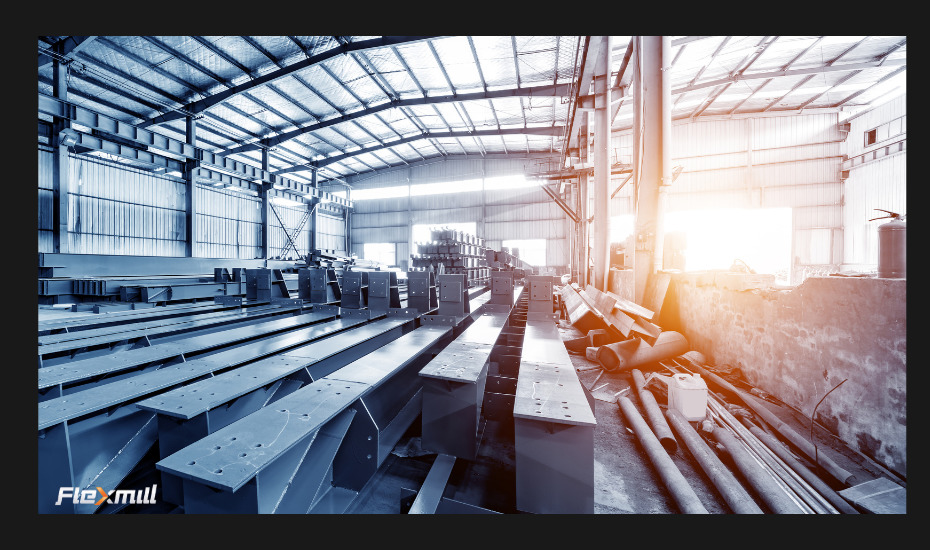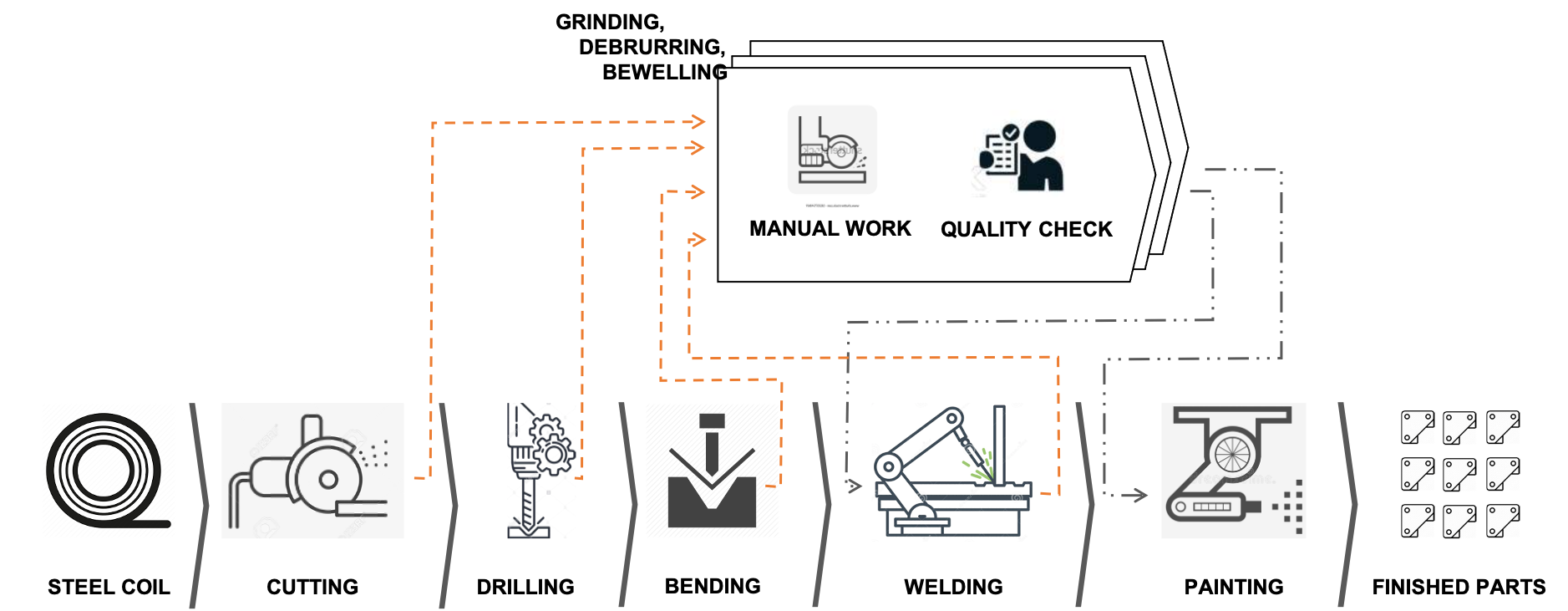
Steel fabricators and service centers are facing more demanding customer requirements and quality standards every year. Intensifying competition means that they must increase productivity and deliver faster projects with lower prices. That’s hard because most steel fabrication process steps – cutting, drilling, bending, welding, machining, coating – are already automated. That’s why steel fabricators and service centers must now automize the hidden work between process steps – such as surface grinding, deburring, and bevelling.
This article describes how you can reduce manual work in the steel fabrication process with a surface finishing robot and the six quantifiable benefits!
There are just a handful of steps in the steel fabrication process. If you are working in a steel fabricator or service centre, you go through these process steps daily: cutting, drilling, bending, welding, machining, and coating.
The steel fabrication process begins by cutting large steel coils or sheets into the correct sizes and shapes mechanically with shearing, punching, and sawing or using cutting processes like laser-, oxy-fuel-, plasma- or water-cutting or other techniques. These processes are most often already done by NC machines. Also, profile drilling is often automated to make holes in the workpieces as programmed.
Then the pieces travel to a press brake for bending. Now the flat steel shapes get the third dimension. After all the part preparation, assembly follows. The parts are held in position with clamps and fixturing, and the structure is fit up into its shape with tack welding.
When everything sits precisely as designed, the welding robot runs through long welds and joins the pieces together. After assembly and welding, most fabrications are machined if needed and finally finished up with coating or painting.
In principle, steel fabrication is a straightforward process. However, as a steel professional, you know that the reality is not that simple!
Steel fabrication hides much work between the process steps. The hidden work items include surface grinding, deburring, and bevelling. For example, after cutting and drilling, you must grind sharp edges to round them up for coating and painting. After machining, you need deburring. Extensive grinding is mandatory always after welding – with weld grinding, you can remove weld spatters and clean and smoothen the surface. Sometimes, you need grinding before welding, too, to remove oxidized metallic layers.
Many manufacturers consider surface finishing simple and quick manual work. In reality, it is the opposite – hard and slow work with heavy and dangerous tools. Separate quality checks are required after manual grinding, deburring, and bevelling. All this eats up precious time.
Click on the image for full size

As a result, manual surface finishing between the steel fabrication process steps slows down your customer projects and reduces productivity, profitability, and quality. You cannot predict production output accurately, and health risks increase sick leaves in the staff.
How does a surface finishing robot improve my steel fabrication process? What are the benefits, and can I get a positive return on investment (ROI)? Here’s a rundown of six benefits helping you to determine how a robot can bring back the invested money – with a typical payback time of 18 months.
Manual surface finishing work is hard, slow, and dangerous. Fast-spinning disc tools expose workers to intensive vibration. Heavy lifting and unergonomic positions wear people out. There is much non-value-adding work while customers only pay for the value add. Robots, however, work fast, according to a programmed schedule, at a uniform phase, without breaks. The tool-on-contact time of a grinding robot is 3-5 times higher than that of a human worker due to minimized time used for air movements and tool positioning.
With a surface finishing robot, you can design the tooling process and development from scratch, choose the right tool types and abrasive media for each task, and optimize the parameters such as tool contact surface area, speed, and contact force.
The faster and more efficient robotic processing is just one factor in the total benefit equation. By automating the material flow around the robot increases efficiency, speed, and predictability even more. Instead of human workers lifting and bearing heavy workpieces, automated lifting and conveyor systems can speed up the surface finishing process between the in-feed and outfeed buffers. Sophisticated clamping systems make fastening parts at every possible position easy.
As you know, all-steel fabrication projects are unique. You might have to process between a couple of dozens of parts to tens of thousands of parts. All parts can be of different weight, size, and form factor. Optimizing the working process for a human grinder would be impossible. In robotics, however, you can take input data from a cutting machine or design program and let the computer build a fully optimized working process for the entire batch of parts. The robot performs accordingly.
When manual work is robotized, you might be able to remove some work steps from your process and increase efficiency. For example, manual grinding always needs a quality check because humans cannot produce uniform quality over a long period and across several workpieces. Robotic finishing, on the contrary, does not need extensive quality checks.
Click on the image for full size

While implementing a robotic surface finishing station allows you to robotize more value-added functionality into the process – centre line and part number marking, 3D laser marking, and etching are excellent examples of this!
Most steel fabricators and service centres have already robotized and automated the main process steps – cutting, drilling, bending, welding, machining, coating. However, a process is only as efficient as its weakest link – manual surface finishing could be your weakest link.
With robotic grinding, deburring, and bevelling you can instantly accelerate the steel fabrication process, commit to faster delivery times, and predict output accurately. You can increase quality radically, improve customer satisfaction and earn a preferred partnership position with your clients.
Do you want to put more steel through your process while improving quality, safety, and profitability? Contact Flexmill for the best advice!
Are you considering surface finishing robot investment? Download our ROI calculator for a best-practice example.